Day 3 of a three day Late Autumn Tour in Norfolk, our last day. The weather forecast was pretty horrible – heavy rain all morning and gale-force winds all day. The kind of forecast when many are tempted to stay at home. In reality, there was rain, but it was on and off for most of the morning and only really heavy for a short period just before midday; and although it was windy, it eased a little in the afternoon and it didn’t stop us. By the end of the day, everyone would agree they were glad we had gone out and given it a go – we saw some great birds!
Given the forecast, we headed over to Titchwell this morning, where we would be able to get out of the worst of the weather in the hides. It was just starting to rain when we met up and coming down steadily by the time we arrived in the car park. Still, it was not bad enough to stop us from having a quick walk round the overflow car park, although a combination of the weather and two campervans which had obviously been there overnight meant there was nothing to see.
We then headed straight out onto the reserve. As we got out of the trees, a Marsh Harrier was hanging in the wind over the reedbed and another was up over Thornham Marsh the other side, presumably birds which had roosted here overnight and were wondering whether to head out, given the weather. A Cetti’s Warbler shouted from deep in the reeds. We stopped for a quick scan of the reedbed pool, although there were just two Little Grebes on there today.
It was not very pleasant out here in the face of the wind, so we headed straight up to the shelter of Island Hide. There were several Dunlin feeding right outside the hide, giving us the chance to get some really up-close views.

We worked our way in turn round the different waders on view from here. There were several Black-tailed Godwits quite close too, and at least 12 Avocets today, further back. A couple of Golden Plover flew in and dropped down on top of one of the new muddy islands, where we could get them in the scope and admire their gold-spangled plumage. A Grey Plover flew in, flashing its black armpits, and dropped down on the next pool over for a couple of minutes.
A Common Snipe was feeding along the muddy edge close to the hide where the reeds were cut back in the recent works, so we had a good look at that too. It was joined by another couple of Common Snipe, which flew in separately, and interesting to see the variation in colour and brightness between them. There had been a Jack Snipe here earlier in the week, but it had been very erratic in its appearances and we couldn’t see it anywhere now.
One of locals in the hide told us that the Little Stint had earlier been on the next pool over – it was probably still there but hidden from view from here behind the new muddy bund. We kept looking over in that direction and eventually he found it again out on the mud with some Dunlin. A nice view, if a little distant – we could see how small it was in comparison with the other waders, before it disappeared back into the vegetation.
There was a nice selection of ducks on here too, with numbers muxh increased now as more birds have returned for the winter – lots of Teal, Shoveler, a few Wigeon and Gadwall, and a couple of Shelduck. A small group of Pintail over in the far corner were feeding actively, upending and showing their pointed tails. A lone Brent Goose dropped in, joined shortly after by several more.
The rain had stopped, so we decided to head round to Parrinder Hide. Before we left, we looked across for one last scan to make sure there was still no sign of the Jack Snipe. Looking along the edge, our gaze alighted on a snipe which was back onto us. Its bright golden back stripes contrasted strongly with its upperparts which looked more solidly dark than the others – the Jack Snipe!
We quickly got it in the scope and everyone had a look. The Jack Snipe was next to a Common Snipe at one point, noticeably smaller and shorter billed. We could also see its distinctive head pattern. Typically, just as we were going to phonescope a couple of quick photos it flew off along the edge of the reeds! At least everyone had a good look at it before it flew.
As we came back out of the hide we heard a Cetti’s Warbler singing right next to the path and watched it scurry through the grass and back into the sallows. It was too windy to stop and scan from the main path, so we continued on quickly round to Parrinder Hide. Good timing as it then started to rain again.
There was no sign of the Little Stint from here at first – we were hoping for some closer views from this side. We scanned through the little groups of Dunlin scattered around the various pools. There were four Ringed Plover in with them on one side of the hide and a Turnstone dropped in briefly. More Golden Plover were visible from here, sheltering from the wind in the lee of the new bund. The Little Stint eventually appeared again with a small group of Dunlin out in the middle, on the small brick island. We got it in the scopes and watched it sheltering from the wind behind the stack of bricks, preening. Then it flew and disappeared again.
The rain had been persistent although never really heavy this morning but just as we thought we were not going to get anything substantial, the heavy rain arrived. For about half an hour it was pretty torrential, accompanied by really gusty winds. The window struts couldn’t even keep the window flaps up! We checked the rainfall radar and it appeared like it might be pretty short lived. Fingers crossed! Sure enough, we could see bright blue sky just to the west and within a very short time the rain had blown through and the skies cleared.

The Little Stint reappeared on its own, back where we had seen it first. We watched it in the scopes, picking along the shore. A flock of Dunlin flew in and landed with it and for the first time we had some nice prolonged views of it.
We had a quick look from the other side of Parrinder Hide, overlooking the Volunteer Marsh. It is pretty overgrown at the moment, but we did see several Grey Plover, including a nice close one looking very smart in the sunshine now. There were a few Redshanks and Curlew too. Various small birds flew up out of the vegetation – several Linnets, with four perching nicely on the top of a suaeda bush, a couple of Skylarks, and a couple of Rock Pipits briefly.
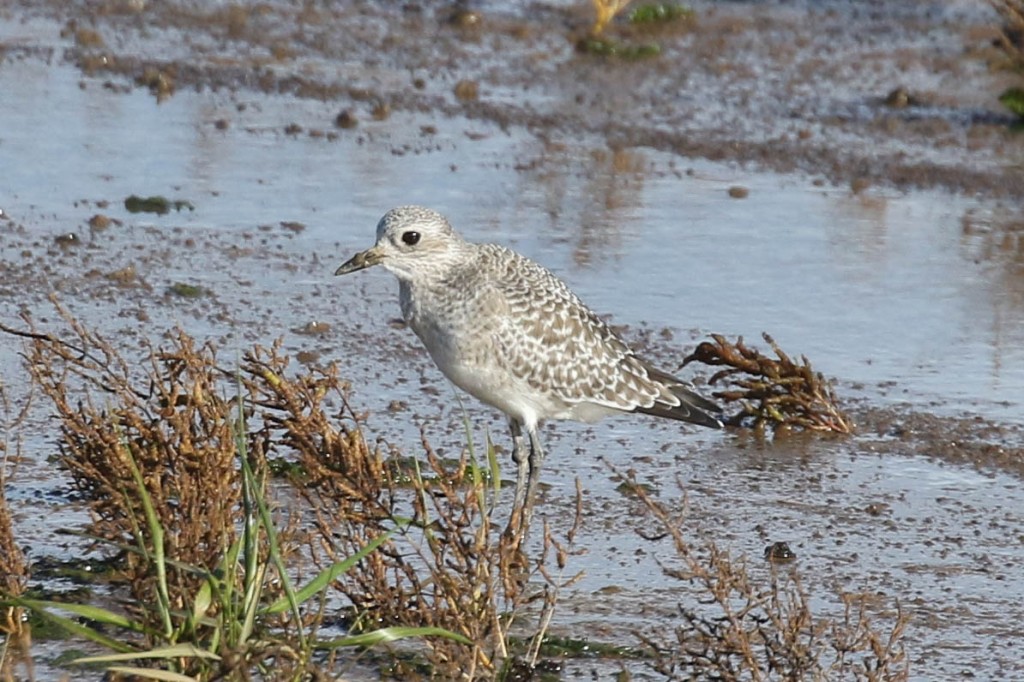
It had been a very productive morning in the hides, and we had successfully negotiated the worst of the weather. Now we decided to head back for lunch.
We stopped again on the main path to admire the flocks of Golden Plover now in the sunshine. A Black-tailed Godwit was feeding very close to the path in the corner by the new bund. When a second Black-tailed Godwit walked towards it, we could hear them starting to call and we watched them first posturing to each other before a fight broke out. They grasped each other by the bill, one flew up and kicked out at the other. Great to watch! Eventually one admitted defeat and flew off, leaving the other in charge of that corner of mud.
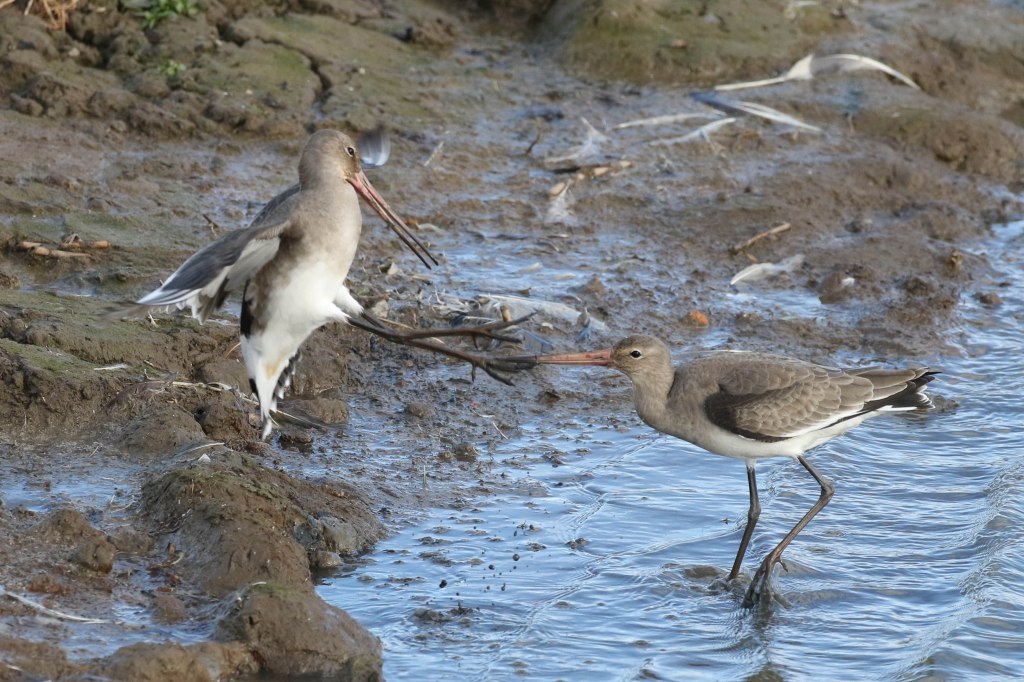
While we were watching the Black-tailed Godwits, we looked behind us to see a small flock of Brent Geese flying in over the saltmarsh. They came right past us, cackling, and dropped down onto the Freshmarsh to drink.
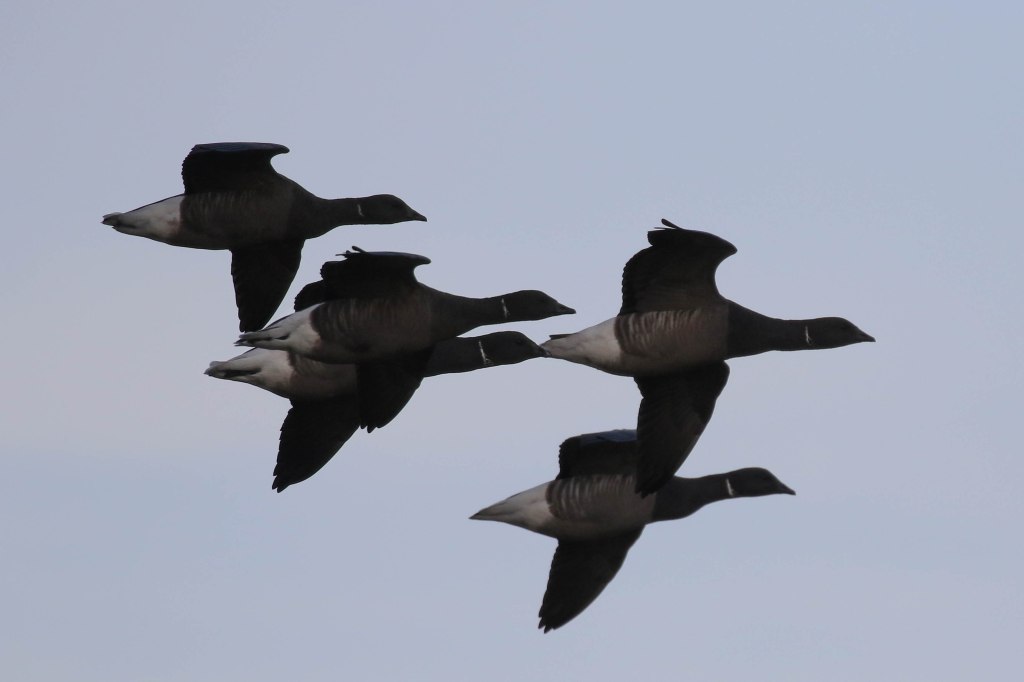
It was still rather windy but the weather was so much nicer now, Still, we head to tear ourselves away as we were getting hungry. We had lunch out on the picnic tables by the Visitor Centre, such was the improvement in the weather, although it was welcome hot drinks all round from the cafe to warm us up.
We heard Siskins calling overhead from time to time over lunch, and just as we were finishing we saw a small group fly into the top of the alders just the other side of Visitor Centre. We walked over there to see if we could find them in the trees, and were just scanning when they all erupted. At least 20 flew out and disappeared round the back of the trees. When they came back past they were swiftly followed by a large raptor and as it banked, we could see the distinctive white square at the base of its tail – a ringtail Hen Harrier! It was only in view briefly before it disappeared behind the trees again, but everyone got onto it.
As if that wasn’t bonus enough, as we walked out onto the reserve and past the reedbed again, a large brown bird came up out of the reeds alongside us. A Bittern! We watched it fly away over the reeds, thankfully going some way and remaining in view for a good long look before it eventually dropped down in again. Our luck was definitely in now!
Past Island Hide, we stopped to scan the Freshmarsh again from the bank. There were several Ruff on here now and we got the scopes on an adult feeding along bund in the middle, its orange legs inviting confusion with Redshank. Some people passing by the other way told us that there had been a Water Rail below us on the pools behind the reeds, so walked further up to where we could see where it had been. There was no sign now, not helped when a Kestrel flew over and caused all the Teal feeding down along the near edge to scatter.
More Golden Plovers had returned to the Freshmarsh now, from feeding in the fields inland. There was a big flock gathered on the bund and the mud just beyond, probably at least 800 of them. From time to time, something spooked them and they flew up and round calling. A pair of Shoveler just below us looked really stunning in the low afternoon sunshine now.

The Little Stint appeared again, back where we first saw it, picking its way along the near edge of the island over towards Parrinder Hide, on its own. It was great light now, an even better view in the scope, we could clearly see its pale mantle stripes.
It was getting on towards high tide, and we were hoping to see if we might be able find the Spotted Redshank roosting on the Tidal Pool this afternoon, so we set off to walk out towards the beach. A couple of Curlews were out in the middle of Volunteer Marsh as we passed.
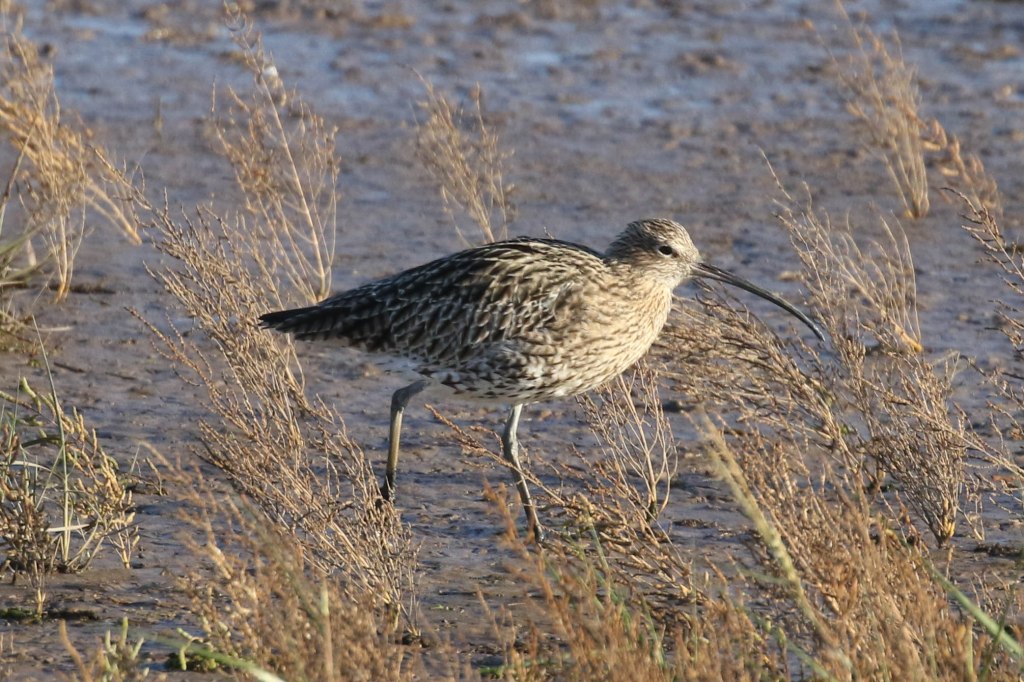
We stopped for a quick scan of the wide channel on the far side of Volunteer Marsh. It can be quiet, but with the tide coming in now and the water level rising rapidly, there were more birds than usual along the edges. One immediately stood out, its much paler white underparts catching the light. Looking through the scope, our suspicions were confirmed, it was a Spotted Redshank. It was feeding in the rising water, wading deep, almost swimming, and upending, but it was possible to see its long, bill when it put its head up. Then it flew across to the other side and was lost to view.
There were several godwits the other side too, and we got our scope on two of them together, a Bar-tailed Godwit next to Black-tailed Godwit, giving us a great side by side comparison. There were several Grey Plover and Common Redshank here too. When all the waders suddenly spooked, the Spotted Redshank flew up and over the bank, dropping down to the Tidal Pools so we walked on to see if we could find it again.
The Spotted Redshank was now showing really well – standing in the water about half way back. We got a really good view of its needle-fine bill and the bold white supercilium in front of its eyes and over its bill. Then it tucked its bill in and went to sleep.
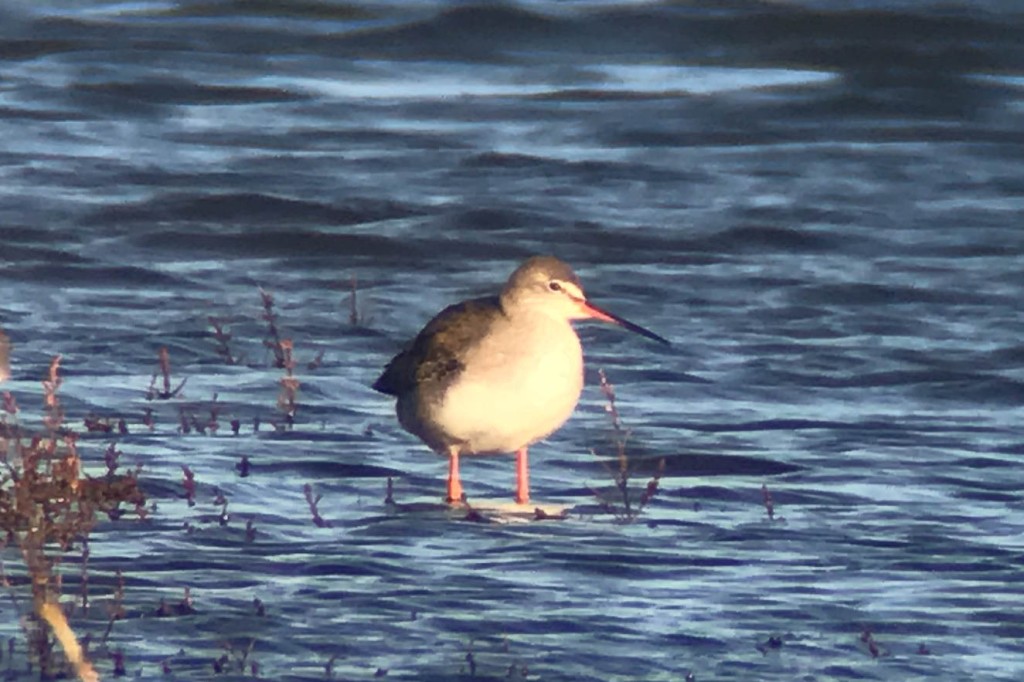
There were more waders roosting on the Tidal Pools a little further up, so we walked on and got the scopes on them. There were more Grey Plover, a couple more Bar-tailed Godwits and several Oystercatcher. Six Knot, our first of the trip, were in with them, noticeably smaller and rather dumpy, with a shortish dark bill visible when one lifted its head. There was a Spotted Redshank here too and we confirmed it was a second bird when we went back to check the first was still asleep back where we had just left it. After a while, the first flew round with a Common Redshank and they dropped in with all the other waders.
Continuing on, there were quite a few waders still out on the beach, despite the rising tide having already covered the mussel beds. Several Oystercatchers were squabbling over the mussels washed up on the high tide line and one of the Sanderlings ran up from the shore and started picking about in amongst them. There were more Bar-tailed Godwits down on the edge of the water too.
We scanned the sea. Two Red-throated Divers were on the water away to the east of us, one still with a small patch of red on its now mostly white throat. There were several Great Crested Grebes, a single Guillemot, and a couple of distant Razorbill too, but no sign of anything we hadn’t seen before.
The clocks had gone back last night, and the sun was already starting to go down. We started to walk back, hoping to catch the gulls gathering to roost on the Freshmarsh on our way. The low late afternoon autumn light was perfect and there was a pink sky backdrop. The colour of the Golden Plover looked stunning now as we got back to the Freshmarsh, they were properly living up to their name.

A lot of gulls were in already, so we stopped to scan through. There were hundreds of Black-headed Gulls, but in with them we picked out a single young Mediterranean Gull, a 1st winter/1st calendar year with heavy dark bill and dark bandit mask. There were quiet a few big gulls too and more arriving all the time, lots of Lesser Black-backed Gulls, and we got the scopes on one standing in shallow water where we could its yellow legs. We found an adult Yellow-legged Gull too, but it was swimming so we couldn’t see its legs. Its mantle was clearly a shade or two darker grey than the Black-headed Gulls around it, its head still rather white, and comparatively unstreaked, rather square, and it was a a big bird with a noticeably heavy bill and large red spot.
A movement on the edge of the reeds below us caught our attention, and we looked down to see a Water Rail scuttle back into the vegetation. Only a couple of the group got a glimpse before it disappeared, but thankfully it came straight back out again. It was very nervous, and kept running back in and back out. It was obviously trying to get to the other side of the new bund, which had broken the line of reeds into two, but it took some time to pluck up the courage. Eventually, it ran up to the top of the bund, where it stopped again wondering what to do, a moment of indecision right out in the open. Then it flew down and disappeared into the reeds the other side.
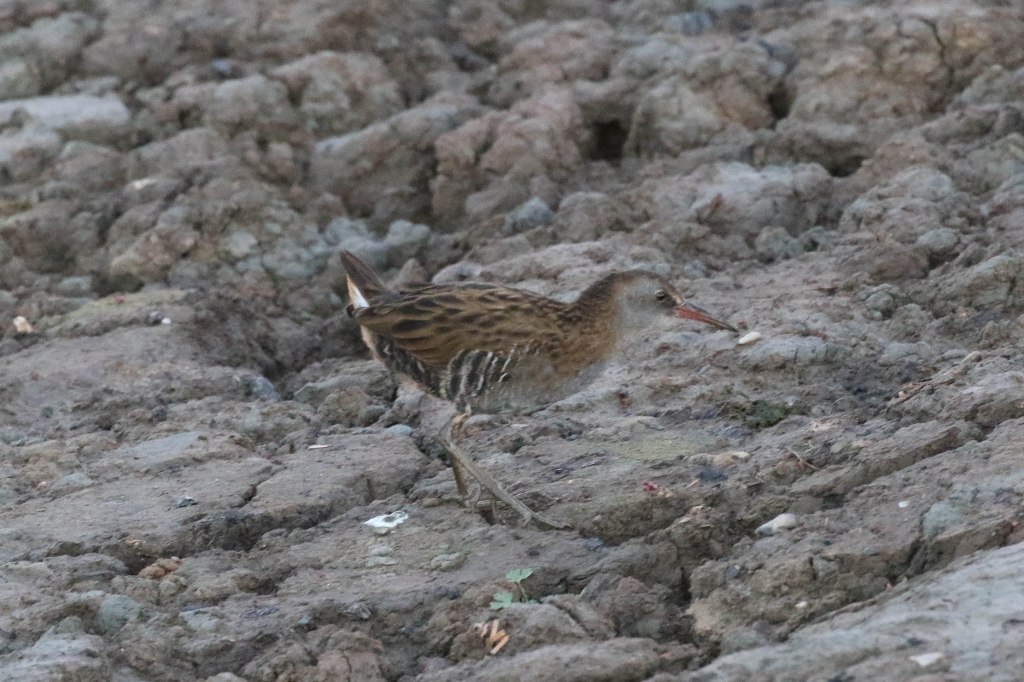
It was time for us to head back, but we stopped for one last scan of the gulls to see if anything else had dropped in. One of the group was looking in the other direction and announced that there was a harrier flying very low over saltmarsh behind us. We all spun round to see a Hen Harrier quartering out over the vegetation, another ringtail we could see the white square at the base of its tail shining in the fading light. We watched it quartering back and forth, then a second ringtail Hen Harrier appeared with it.
What a great way to end the trip, watching the two Hen Harriers hunting in the last of the autumn light. As we drove back to drop everyone off, we reflected on what an amazing day it had been, particularly given our low expectations and the weather foreacast this morning. Just goes to show, you never know and it is always worth going out. You won’t see anything if you just stay in!
















